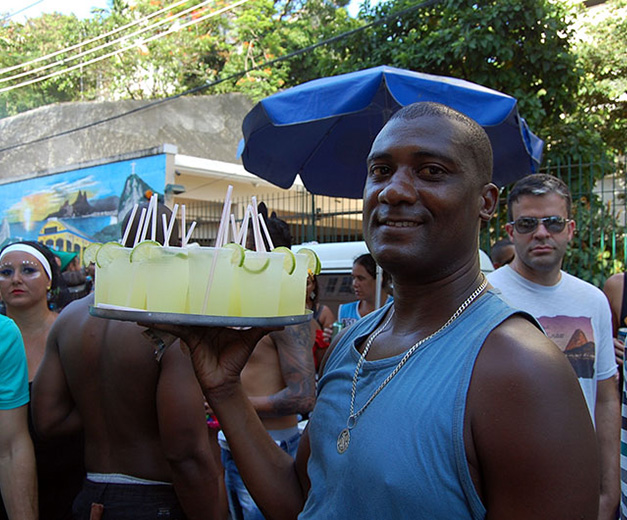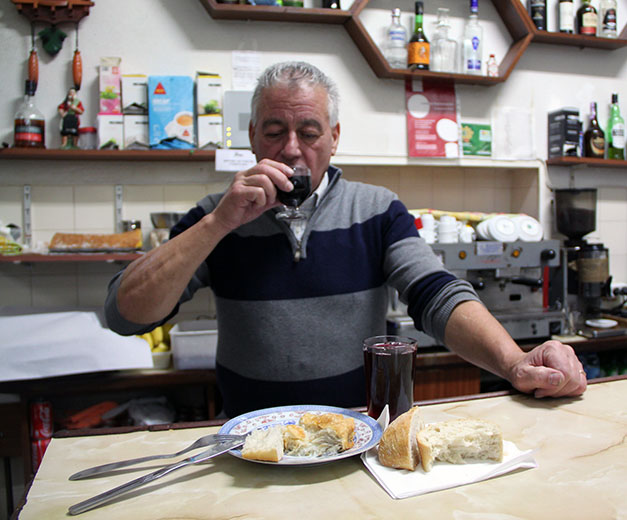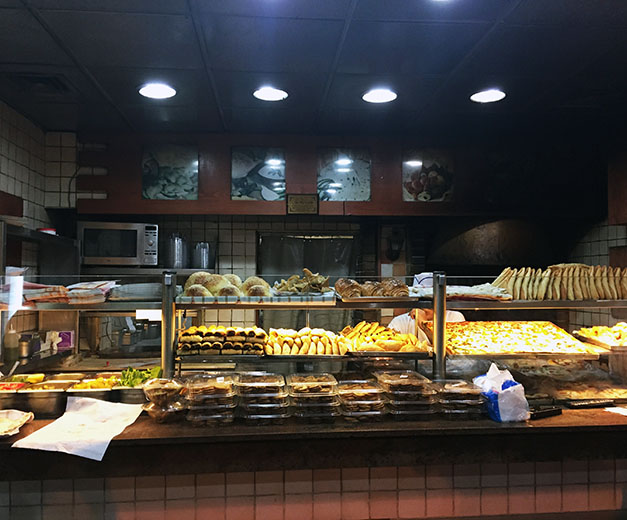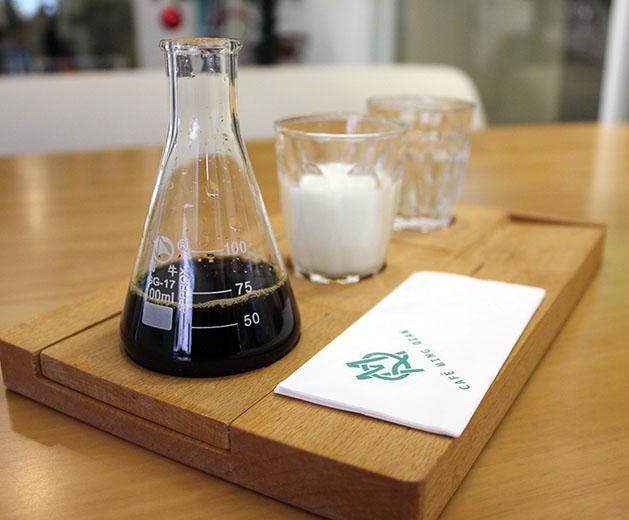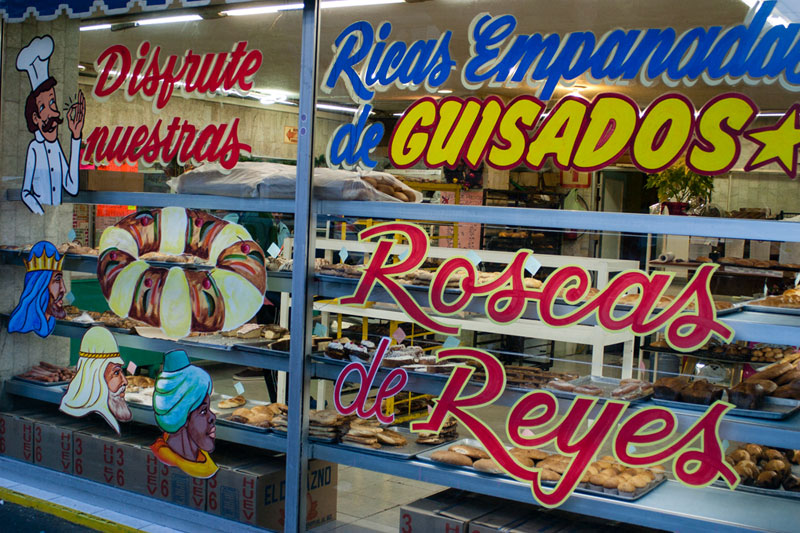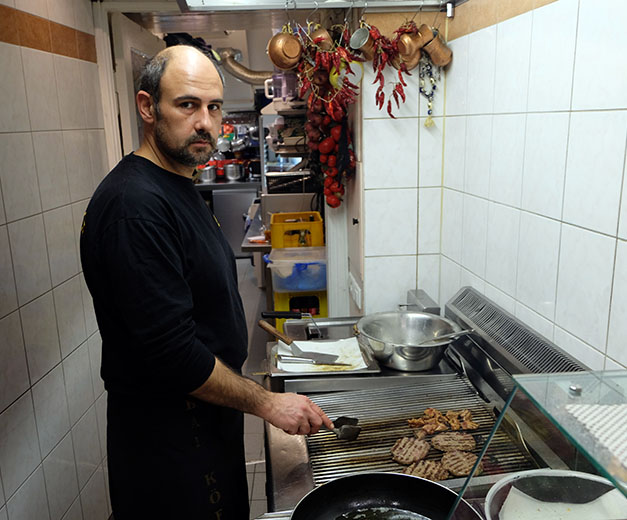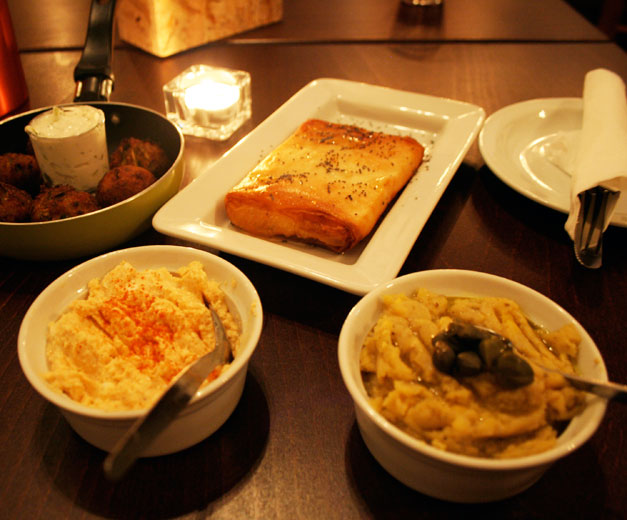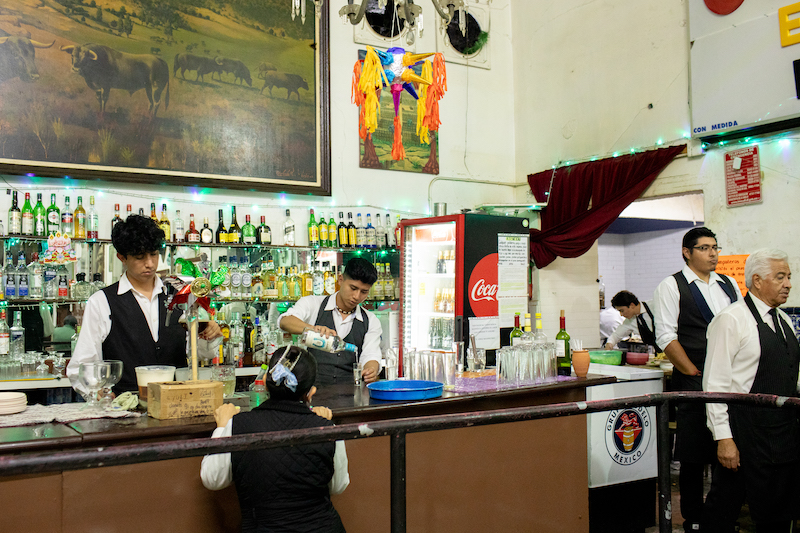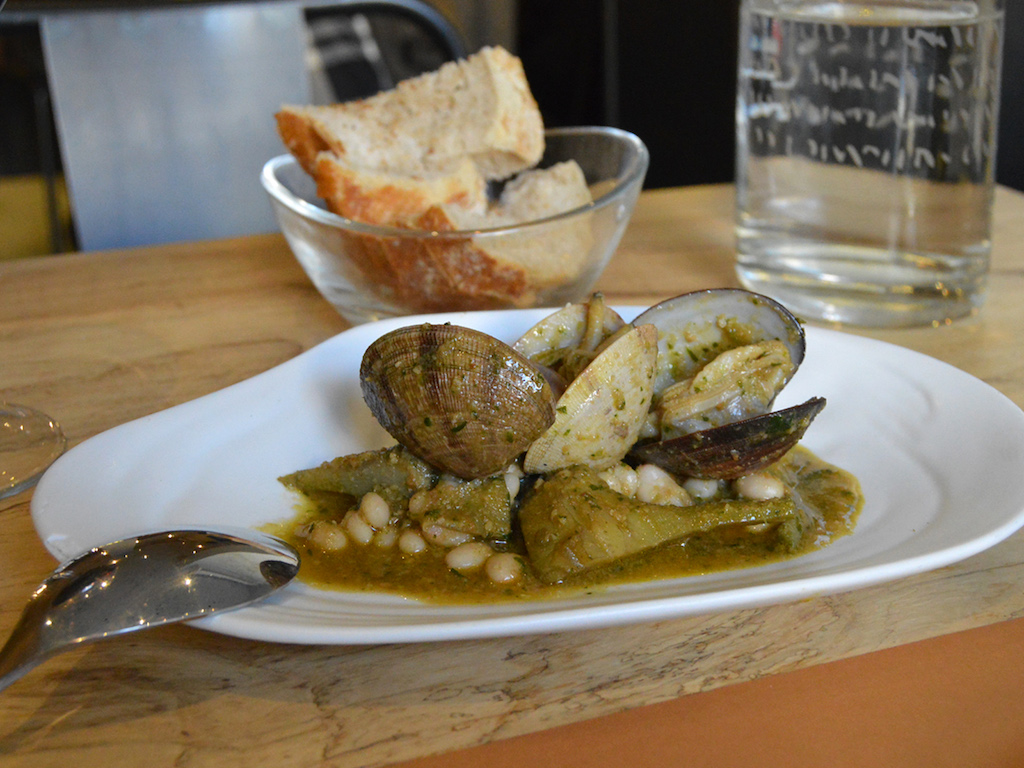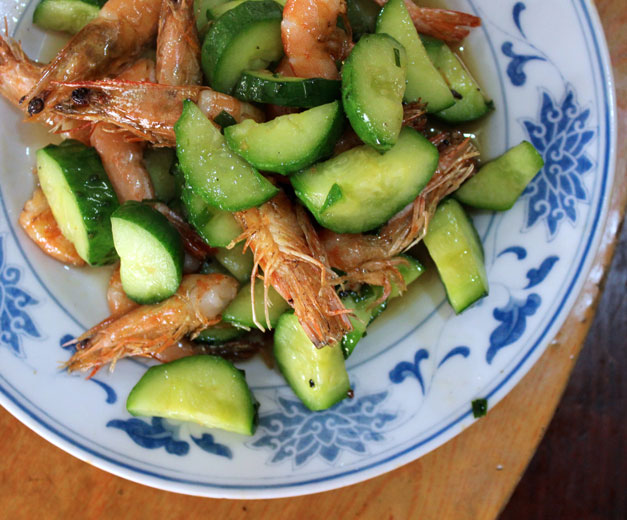We can't find the internet
Attempting to reconnect
Something went wrong!
Hang in there while we get back on track
Search results for
Rio
Liquid Carnival
In the anything-goes lead-up to Lent, Carnival in Rio is as much about public inebriation and bawdy public displays of affection as it is about extravagant costumes and entertainment. It’s also a time when freelance moneymakers can largely evade municipal guards by dressing up in costumes as fanciful as any carnivalgoer while they sell their homemade alcoholic concoctions unlicensed. Carnival is early this year – Ash Wednesday is February 10 – which means the city’s sinning is in full swing from now onward. Culinary Backstreets scouted out some of the alternative alcohol options you’ll find on the streets this time of year, ones both classic to hundreds of themed street-party blocos and some that seem to be one-of-a-kind offers.
Read moreQueens
Introducing "Queens Migrant Kitchens"
Culinary Backstreets presents a year-long monthly series of stories on migrant kitchens from the world’s most diverse place – Queens, NY. Through interviews, photos, maps and short films, the Migrant Kitchens Project will share not only what challenges and joys immigrants face as they create their new home but also how they strengthen the city.
Read moreShanghai
Auspicious Eating: Ringing in the Year of the Monkey
As the moon starts to wane each January, people throughout China frantically snatch up train and bus tickets, eager to start the return journey to their hometown to celebrate the Lunar New Year (春节, chūnjié) with their family. This year, revelers will make an estimated 2.5 billion journeys on the train system alone, up 100 million from last year; at least another billion bus, plane and car trips add to the travel chaos. One of the major draws for migrant workers heading home is the chance to eat traditional, home-cooked meals with relatives. You won’t get through a conversation about Spring Festival, as the holiday is also known (“Spring Festival” is the literal translation of chūnjié), without a local waxing poetic about the holiday’s dishes, which vary region to region but have one very important thing in common: delicious symbolism. These festive meals pull double duty, using allegorical shapes and homophones to add prophetic wordplay to family dinners.
Read moreAthens
Loukoumades: An Ancient Doughnut Hole’s Revival
In the era of such food crazes as the “cronut,” it seems that every city has its own classic fried-dough treat that is now being reimagined, and in Athens, loukoumades (think of them as the Greek predecessor of doughnut holes) seem to be getting a major overhaul as of late. Why revamp such a perfect childhood classic, you might ask? Loukoumades are considered to be one of the oldest recorded pastries (and desserts, for that matter) in the world – in fact, the ancient Greek poet Callimachus and philosopher Aristotle wrote about these bite-sized, fluffy fried-dough balls. The triumphant winners of the first Olympic games in ancient Greece were the ceremonious recipients of xarisioi plakoi (χαρίσιοι πλάκοι), or honey gift-cakes.
Read moreTbilisi
Citron Plus: From Stage to Table
Tbilisi’s Vake Park district is an upscale neighborhood full of designer cafés and fancy-looking Georgian-European restaurants offering mediocre grub at prices that complement the black SUVs and silver Mercedes that crowd the streets. Sure, you can find a good place that serves up the typical tasty Georgian menu at a fair price. But for original Georgian cooking with particular attention to fresh ingredients and the process of putting them together so that all the individual flavors explode in your mouth, look no further than Citron Plus.
Read moreBarcelona
La Cuina del Guinardó: Refinement, to Go
Up in the high streets of the Horta-Guinardó hills, not far from the old historic building of L’Hospital de La Santa Creu i Sant Pau, there is a restaurant with a big concentration of culinary talent but just eight tables. To make things worse, they are only available during two hours for lunch. Fortunately for those who can’t snag one of those precious tables, La Cuina del Guinardó (“Guinardo’s Kitchen”), a Catalan traditional market-cuisine restaurant, is also a store selling cooked food to take away from morning to evening and a great wine shop, with a tasting area in the upper level.
Read moreIstanbul
Korkmaz Büfe: Poetry in Rotation
Istanbul’s Kadıköy district on the city’s Asian side has long been billed as a calmer, more laid-back alternative to some of its swarming, chaotic European counterparts, and it seems everyone’s figured that out by now. Though the rocks that straddle a long stretch of winding, serene shoreline still make for one of the most relaxing hangout places in the city, the pedestrian Mühürdar Caddesi running through the heart of Kadıköy is choked with foot traffic on the weekends, while a staggering number of bars and coffee shops have appeared on the scene within the past two to three years.
Read moreLisbon
Reviravolta: Fernando’s Hideaway
A particularly eye-catching landmark in Lisbon’s Alfama district is the Casa dos Bicos (“House of the Spikes”), a 16th-century palace – once home to the Portuguese viceroy of India, and now housing the José Saramago Foundation – that has a bizarre façade of spiked stones and eclectic doors and windows. Just next to it is Reviravolta, a modest neighborhood tasca that serves up a dish with similarly iconic status: cozido a Portuguesa. One of the most traditional Portuguese meals, cozido has humble origins; first invented in the interior Beira region, it was a dish to use up all the week’s lunch leftovers. It consists of a mixture of several kinds of meat, including chicken, pork ribs, pork belly, pig’s ear, beef shank and assorted offal, complemented by different smoked sausages: chouriço, fat and sweet paprika, blood sausage and farinheira – the latter a Jewish invention of wheat flour, paprika and pepper, nowadays mixed with pork fat. Cozido is accompanied by boiled vegetables such as beans, potatoes, cabbage, turnip greens and rice. All of that, on just one plate.
Read moreRio
Zeca's Restaurante: Eating on Rio’s Fantasy Island
Watching residents of Paquetá Island between the turnstiles and gate to get their ferryboat home from Rio’s central Praça XV port is like watching horses chomp at the bit before their stable doors are opened. The 5,000 proud homebodies of Rio’s little car-less island in the center of Guanabara Bay are anxious to get back to it, often pulling tall shopping carts stacked with beer and snacks. There’s only one small grocery store on the island and what gets here, gets here by boat and human hands. The ferry is a destination as much as a journey for those who want to appreciate one of Rio’s most unique little corners. You’ll question the quiet here and remember that this city of 14-lane highways is set to a constant soundtrack of engines and “PORRA!” (Pronounced POU-hah, this is a ubiquitous carioca curse you’ll hear when someone’s mildly upset or surprised, a much saltier version of “damn it!”)
Read moreMexico City
CB on the Road: Striking Culinary Gold in Zacatecas
Although, thanks to its once flourishing silver and gold mines, the north-central Mexican state of Zacatecas was an economic powerhouse during the colonial period and the early years of the Mexican republic, its cuisine is not as well known in Mexico City as that of states such as Oaxaca and Michoacán. But when we headed this past New Year’s to the state’s eponymous capital city, we were blown away by its food, as well as its history and beautiful colonial architecture. Zacatecas played a significant role in Mexico’s economy during the colonial period: When the Spanish conquistadors learned about the region’s rich mineral deposits in the mid-16th century, they started mining operations immediately. In 1585, the city that had grown from the mining settlement was recognized by the Spanish crown and called the “Muy Noble y Leal Ciudad de Nuestra Señora de Zacatecas.”
Read moreAthens
Kali Parea: In Good Company
Settled by Greek refugees from Turkey after 1923, Nea Erythraia is a northern suburb of Athens that started off very low-key and has now evolved into a buzzing shopping and nightlife area, full of cafés, bars, restaurants and gelaterias. Despite the recent boom, many places that have been local favorites for over a decade now are still popular. One such venue, a small, unassuming restaurant with the welcoming name of “Kali Parea” (meaning “good company” in English), is hidden in a quiet street off the main road. Its faithful clientele come here to savor seasonal fish (mainly small fry) and seafood (calamari, octopus and shrimp), prepared either fried or grilled.
Read moreShanghai
Top Buns: Shanghai’s Best Baozi
Bāozi (包子), or steamed buns, are a basic, on-the-go meal. It’s rare to come across a shop selling these buns for more than 1.5 RMB (US$0.25), and yet, the past five years have seen a dramatic rise in the stature of this humble dish – thanks mostly to celebrity chef David Chang, whose Momofuku pork bun has become world-famous. They even got a domestic boost in 2013, when President Xi Jinping visited a local 60-year-old baozi shop in Beijing. (Now, thanks to an hours-long queue to try the “President Special,” that chain is looking to go public.) Legend has it that baozi date back to the Three Kingdoms period (A.D. 220-280) and are credited to Zhuge Liang, a renowned military strategist who was also an eccentric foodie. He invented both this steamed bun and our favorite breakfast treat: the jianbing
Read moreRio
Olympic Zone Eats: Tia’s Hot Dog Stand
Though Brazil is rich in mother earth’s most colorful produce – like passion fruit, guava, papaya, collard greens and sweet abóbora pumpkins – residents of Rio nonetheless have a steady love affair with hot dogs, which are pronounced “HOH-tchee DOH-geey,” or literally translated into Portuguese as cachorro quente. Vendors across the city pile the bunned favorite with a set of toppings as elaborate as they are consistent from one cart to the next: hard-boiled quail eggs, green peas, corn, potato straws, stewed onions and Parmesan cheese. “Tia” was a young mother of three with a husband whose blue-collar salary as a cop meant life was a hustle in their working-class neighborhood of Freguesia. “I had to take them all to school, prepare breakfast, the school uniforms,” she said. “I got no rest.” Her hot dog vendor days began in 1982, when her daughter was a newborn, and she had what she now says were two decades of busting her chops before the cachorro quente da Tia would become one of the most in-demand snacks in this periphery neighborhood of Rio. “Thank God,” she says of her success in her hot dog business, which now encompasses both a quiosque and a store, with 16 employees in total.
Read moreIstanbul
“I’ve Come and I'm Gone”: A Tribute to Istanbul’s Street Vendors
Metin Akdemir is a filmmaker based in Istanbul. In 2011 he made a short film about street vendors in the city. The film, “Ben Geldim Gidiyorum” (“I’ve Come and I’m Gone”), won several awards in Turkish and international film festivals, and we think it’s a very valuable piece of work that captures a side of Istanbul’s culture that is slowly disappearing.
Read moreLisbon
A Taste of Home: Lisbon Cultural Associations
Portuguese regional food can be found easily in Lisbon, but at Grupo Excursionista e Recreativo Os Amigos do Minho, it is one of its raisons d’êtres. This warren of rooms that occupy a 19th-century tile-clad building not only works as a restaurant; the small cultural association has been a point of encounter for internal migrants moving from the northernmost Portuguese region of Minho since the 1950s. For all that time, this humble spot has kept the Minho culture alive in the capital, as well as renting out the space to young music promoters and cultural producers. Here you can experience rowdy parties with northern-style dances, live performances of the “concertina” (a typical accordion from the region) and, most importantly, group dinners with local, traditional food.
Read moreLisbon
Lisbon: State of the Stomach
Lisbon, one of the world’s oldest cities, has a grand and turbulent past. Due to its position on the Atlantic Ocean, the Portuguese capital has been an important international trading post for centuries, flooded by a wide range of cultural influences and culinary tastes. The Romans, Arabs and Phoenicians all left their mark here, particularly with that lasting and classic trilogy: bread, wine and oil. The trade route opened by explorer Vasco da Gama in the 15th century also brought in spices and herbs little seen elsewhere in Europe at the time, and spices such as saffron, pepper, cinnamon and nutmeg are still integral to Lisboetas’ kitchens today.
Read moreTokyo
Nihonbashi Suminoe: Catch of the Night
As the towers of Tokyo’s Nihonbashi financial district began to proliferate and grow taller, developers took special care to preserve and in many cases not displace the area’s mainstream department stores, art galleries and varied restaurants, and so traditional establishments were often incorporated into the new buildings. The Mitsui real estate group, which opened the two Coredo Towers in 2014, made sure to include time-honored restaurants in the new setting, including an amazingly good, classic Edo-mae sushi bar lured from an outdated setting, an outpost of a Kyoto home-cooking restaurant and a dazzling array of famous sweets shops. The developers were also clever enough to include a classic izakaya, or pub-style establishment, enticed away from the Tsukiji market. Every evening, office workers pour out of local mega-buildings and pack into Nihonbashi Suminoe to enjoy the collegial atmosphere and flavorful charcoal-cooked fish. Sakaya means a location in which to purchase sake, and “i” means to stay in a place and feel at ease. Thus, i-sakaya becomes “izakaya” when pronounced correctly, and it’s the perfect way to describe Nihonbashi Suminoe.
Read moreBarcelona
Can Pineda: A Workers' Canteen Grows Up
The rustic family favorite Can Pineda has been holding down this corner of Barcelona’s El Clot neighborhood since 1904. It was not a restaurant originally, but a typical wine shop and canteen, where plenty of life could be found amongst the wooden barrels that now slumber peacefully on their perch up above the dining room. At that time, the place was frequented by local factory workers, who would come for a glass of wine to go with a simple meal or to drink while warming up their lunch boxes. The then-owners would put a pine branch on the door to signal the arrival of the vi novell, or new wine of the year, and from the pine, pi in Catalan, came the name Can Pineda, which translates roughly to “The Pine House.” Today, El Clot is part of the new high-tech 22@ district, which is focused on innovation and research but maintains in its oldest streets the spirit of the village (Sant Martí de Provençals) that once flourished here, with its own market (dating back to 1889) and walls that remain from Barcelona’s first Industrial Age. Can Pineda sits right in the middle, a small but welcoming eatery with just 30 seats, decorated with the characteristic blue azulejos tiles, those wooden barrels and a few excellent hams hanging behind the bar.
Read moreElsewhere
Breakfast in Beirut, Part 3: The City’s Best Manousheh
The manousheh (plural manaeesh) is one of the defining staples of Lebanese food. In a country known for its divisions, the universally loved manousheh might be the breakfast food that unites all Lebanese. A manousheh is a round flatbread cooked in a big oven or on top of a saj (a domed oven prevalent in the Levant), traditionally topped with zaater (a mix of thyme, olive oil, sesame seeds and sumac) or salty white akawi cheese. Manaeesh can be sliced or folded and, much like pizza, they can be thin or thick. In modern times, toppings have come to include a whole range of different ingredients, and there are even now dessert manaeesh that are topped with Nutella. Manaeesh are so popular that there is not one neighborhood, town or even remote village where they are not made.
Read moreRio
Bar do Alto: Return to Babylon
You get to Bar do Alto by taking a zippy mototaxi up the snaking streets of the Babilônia favela and then walking 10 minutes up jagged staircases that eventually bear right. On the route, you’ll pass by slices of life that make favelas a museum of Rio, where the city’s symbols and icons are on display in the bare and human way that’s made possible by close quarters of self-made dwellings. There are the evangelicals raising their voices in weeknight prayers. Shirtless men with leathered skin that speaks to long day jobs, now tipping back tall evening bottles of beer. Children playing soccer as overheated cops in bulletproof vests slump on nearby benches.
Read moreIstanbul
Deniz Lokantası: Souperior Stock
When we picked up a cab from Meşhur Unkapanı İMÇ Pilavcısı recently, it turned out the driver had just been there for a refuel himself. Sensing a captive yet interested audience, he held forth all the way to Beyoğlu about where to eat well and cheaply – without stomachaches ensuing – in Istanbul. We’re always happy to discuss the finer points of kuru fasulye (stewed beans), but this driver seemed to have a particularly deep interest in the subject. After debating the merits of various canned brands (“Yurt” brand or nothing, in case you were interested), he dived into the subject of soup.
Read moreAthens
Kapetan Mixalis: Cretan Kitchen
This small, charming <em>mezedopoleio</em> gets its name, which translates to “Captain Michael,” from Nikos Kazantzakis’s eponymous novel. The tribute to Kazantzakis makes sense: The eminent writer and philosopher was a native of Crete, as is the family that opened this eatery some 50 years ago. <!--more--> In the 1960s, Kapetan Mixalis was more café than mezedopoleio (the Greek equivalent of a tapas bar), offering coffee, backgammon (<em>tavli</em> in Greek), card games, live music by locals, philosophical discussions and a friendly atmosphere from morning till night. It became a meeting point for Athenian intellectuals, actors and musicians. Famous personalities sat for hours at the sidewalk tables, quaffing wine and a traditional Cretan drink called <em>tsikoudia</em> (a grape-based brandy) and eating cold cuts, spoon sweets and other simple preparations that didn’t require cooking.
Read moreTbilisi
Chaotic Holidays to You: The Dezertirebi Bazaar
While much of the West celebrates Christmas in an orgy of shopping for presents that climaxes after a single dinner, Georgians commemorate the season with a 30-day binge of feasts that pretty much begins on December 17, Saint Barbara’s Day (Barbaroba), and peters out by January 19, the Orthodox Epiphany (Natlisgeba). Unlike Americans, Georgians don’t consume stuff for the holidays – they annihilate food. The best, if not most chaotic, place to stock up on victuals is the Dezertirebi Bazroba (“Deserter’s Bazaar”). Located near Tbilisi’s central train station, this raw, disorganized, 2,000-square-meter warren of unprocessed agrarian pabulum is the city’s largest open-air market.
Read moreShanghai
Shanghai’s Top Coffee Spots, Pt. 2
Since we last wrote about the best places for a cuppa back in 2014, Shanghai has become the city with the third-highest number of Starbucks in the world, and these new shops serve flat whites and cold brews from an interactive barista bar. We should expect more of these fancy cafés, as the Seattle coffee chain is planning to double its current number of stores in China by 2019 – going from zero to 3,000 in 20 years.
Read moreMexico City
Rosca de Reyes: A Tradition Fit for Kings
In Mexico, Epiphany (or Día de Reyes, in commemoration of the Three Magi’s visit to the baby Jesus), celebrated on January 6, offers an opportunity to extend the Christmas season. Mexican kids go to bed early on January 5, expecting to find gifts next to the Nativity scene the following morning. The traditional way to celebrate this holiday is by eating rosca de reyes ("kings’ cake"), an anise-scented, ring-shaped cake or sweet bread decorated with slices of candied fruit.
Read moreElsewhere
Bal Köfteci: Sweetish Meatballs
It might sounds sacrilegious, but when we’re in Berlin, döner isn’t our go-to street sandwich. Though it is widely believed that the German capital is the birthplace of the beloved sandwich, that fact alone does not provide citywide quality assurance. The rapid ascension of the döner sandwich as the city’s eminent fast-food staple has unfortunately resulted in its mass production, which means one is likely to encounter a nondescript rotating wheel of frozen mystery meat. This isn’t to say that excellent yaprak döner (a carefully crafted cylinder consisting of freshly layered cuts) cannot be found in Berlin. But the way the sandwich is dressed in this city – with a variety of vegetables, sauces, cheese and fresh-squeezed lemon or lime – is indeed conducive to covering up the taste of boring meat.
Read moreTokyo
Osechi Ryori: Edible New Year
'Tis the season of the Japanese New Year's trinity: osechi, oseibo and nengajo. Like newsy Christmas cards, the nengajo is a recap of family or personal news mailed in postcards during the weeks preceding the end of the year and efficiently delivered all over Japan promptly on January 1. The winter gift-giving season is in full swing, with companies and individuals sending oseibo gifts as thank-you expressions for kindnesses over the year. Most gifts are food or household items like cooking oil or soap. The best of the traditions is osechi ryori, traditional New Year’s cuisine. Osechi is not something one can find in a restaurant because it’s eaten only one time a year, at home or when visiting others at home. The first days of the new year are for resting and rejuvenating, including for those responsible for providing meals, traditionally women. All stores and most restaurants are closed. Food is prepared ahead of time with materials that can be preserved, to be eaten over several days beginning on New Year’s Day.
Read moreElsewhere
Tsipouraki Mezedaki: Old Town, New Life
Nicosia’s Old Town grabs your senses in many different ways. You still enter it through 16th-century Venetian walls. Wander its narrow streets and you’ll see architectural shadows of the Ottoman, French and British regimes that have ruled Cyprus over the past 500 years. Turn a random corner and you’ll hit a fierce-looking razor wire and oil drum barrier with an overgrown and abandoned buffer zone beyond, reminding you that this is Europe’s last divided capital, in stasis since 1974, when a short-lived coup aimed at uniting the island with Greece sparked a Turkish invasion of the northern third of the island.
Read moreMexico City
La Faena: Union Made
From the point in 2002 when multibillionaire Carlos Slim inked a deal with Mexico City to revitalize its historic center until now, there have been layers of change. Streets were made pedestrian-only after months of work by bulldozers and jackhammers. Broken windows and abandoned buildings have been replaced with countless new shop fronts offering shiny opportunities. Despite the strictures of tough legal bulwarks against eviction, a Giuliani-esque wave of economic empowerment has swept the city’s center, spray-brushing away signs of endemic poverty in ironic lockstep with scheduled protests by social-justice movements ranked by those who casually grab a bite after the march. Crowds are swelling along the planned corridors.
Read moreRio
Olympic Zone Eats: Chácara Tropical
Editor's note: As Rio gears up for the 2016 Summer Olympics, CB has been exploring the backstreets of the city's Olympic Zones in search of gold-medal eateries. This is the first dispatch in the series. Barra da Tijuca was meant to be the best of Rio without its worst. Sandy beaches with no pickpockets. Top-notch shopping with no annoying squawking vendors. Playgrounds with no worrisome outsiders – because those playgrounds are inside gated condominiums with guards who sometimes have pistols tucked into their belts. The Avenida das Américas is 14 lanes wide, enough space for everyone to have their own car and leave the bus lanes to the white-uniformed maids and servicemen and women who bustle into Barra each day.
Read moreIstanbul
CB on the Road: Gabo, Diyarbakır’s Veg Rebel
My wife, Kurdish in-laws and I are enjoying an early meal at Gabo, one of Diyarbakır’s most successful new restaurants. It gets dark early this time of year in the city, and the dry air carries the ayaz chill, which engenders a need for a hearty soup and hot tea. The owner, Cahit Şahin, shares stories of the place’s beginnings. “When we applied for a restaurant license, City Hall just laughed,” he tells us. “‘For a vegetarian place?’ they said, ‘In Diyarbakır? Go ahead! It doesn’t matter if we grant you one or not. You’ll go under in three months!’” But that was nine months ago. Gabo, which bills itself as the predominantly Kurdish southeast region’s only vegetarian restaurant, is thriving. In fact, they are doing so well that Şahin and his fellow owners are planning to open franchises in the western Turkish city of Tekirdağ and in Istanbul. As Şahin talks, he gestures at the bustling café around him. “We used to work as tutors for students preparing for their standardized exams. We were just sick of the rat race, of always being tired and worn out. I envisioned a cozy alternative joint where I could drink tea, listen to jazz and play backgammon with my friends.” He laughs. “We haven’t touched a backgammon board since we opened the doors!”
Read moreTbilisi
Tbilisi Sketches: Muscling Up Some Churchkhela
Tbilisi stores and markets are festooned now with distinctive sausage-shaped candies called churchkhela, ready for New Year celebrations and then Orthodox Christmas on January 7. They are a very traditional Georgian specialty, usually homemade from grape juice thickened with flour and nuts.
Read moreAthens
Cookie Season: Athens' Best Kourambiedes
You can’t have Christmas in Greece without melomakarona and kourambiedes, two traditional cookies that are present in every household this time of year. The former were once prepared for Christmas and the latter for New Year’s, but gradually the two treats became inseparable (because why have one when you can have both?). Kourambiedes (the singular is kourambies) are believed to originate from the Azeri Iranian city of Tabriz, where they are called qurabiya. The Greeks, it appears, borrowed the name for their cookie from the Ottomans, who called them kurabiye (kuru meaning “dry” and biye meaning “biscuit”). Besides in Greece, variations of kourambies can be found throughout the Middle East, Turkey (kurabiye), Cyprus (kurabies), Albania (kurabie) and Bulgaria (kurabiiki), as well as the Andalusian part of Spain and Mexico (polboron).
Read moreAthens
Best Bites 2015: Athens
Editor’s note: We’re celebrating another year of excellent backstreets eating by taking a look back at our favorite restaurants and dishes of 2015. In a country that can boast of very few authentic (if there can be said to be such a thing when it comes to cooking) Greek desserts, galaktoboureko remains quintessentially Greek. This semolina custard pie of cream between layers of thin phyllo doused in syrup remains a firm national favorite. Kosmikon is the undisputed king of Athenian galaktoboureko. An old-fashioned dessert shop operating since 1961, it now has five locations around Athens. The galaktoboureko here is done the traditional way, with butter from Thessaly in central Greece or Mytilene, homemade phyllo and – most importantly – no lemon or orange flavoring, just the traditional vanilla. The result is that rare thing when it comes to phyllo-based, syrup-drenched desserts: a wonderfully balanced concoction, sweet but not too sweet, with cream oozing from the sides, and the phyllo remaining thin and crisp. We recommend going to the two central locations in Agios Nikolaos and Agios Eleftherios for their charmingly retro atmosphere.
Read moreBarcelona
Best Bites 2015: Barcelona
Editor’s note: We’re celebrating another year of excellent backstreets eating by taking a look back at our favorite restaurants and dishes of 2015. La Panxa del Bisbe Xavi Codina has created a menu of almost 30 tapas or platillos (small dishes) and four desserts, combining traditional Catalan cuisine with international influences that Codina has encountered in his life or in the neighborhood. Much of the menu changes according to season and customers’ tastes, but there are a few perennial favorites, such as the homey croquettes, with their generous quantity of chicken and carrots; duck liver with pears and wine; and the cap i pota, a traditional dish made from pork trotters and head, which the chef tweaks throughout the year.
Read moreShanghai
Best Bites 2015: Shanghai
Editor’s note: To cap off the year, we’re taking a look back at all the best eating experiences we had in 2015, and in Shanghai, that means everything from fried pork buns to shakshuka made with local ingredients. Yang Yang’s Dumplings The chengguan were out in full force shutting down our favorite street food hot spots this year, including one of Shanghai’s most popular night markets on Fangbang Lu and the soon-to-be-closed Tangjiawan market. We’re reminded that it’s ever more important to support those vendors who take pride in their craft and hand-make everything from start to finish.
Read moreTbilisi
Best Bites 2015: Tbilisi
Editor’s note: Tbilisi was a new addition to Culinary Backstreets this year, and as we look back on all the great eating we did in 2015, we can’t help but notice that so much of it took place in the city's Sololaki area. There’s a typecast in Georgia that when somebody wants to go into business, they open up a khinkali restaurant. There is a logic to that. About a million people live in Tbilisi, a city built impetuously along the hilly banks of the Mtkvari River. And the adoration every single one of these people has for this boiled dumpling is so reverent, it is as if they see Jesus and his disciples feasting on a steaming platter of kalakuri khinkali for the Last Supper as they bite a hole into the dumpling and slurp its tasty broth.
Read moreIstanbul
Best Bites 2015: Istanbul
Editor’s note: To give 2015 a proper send-off, we’re taking a look back at all our favorite eating experiences this year. Hamo’nun Yeri The nohut dürüm, a simple wrap of mashed chickpeas, peppers, parsley and spices, may be a popular breakfast choice in certain districts of the southeastern province of Gaziantep, but we'll eat it anytime and are prepared to travel far and wide to do so, as this treat is by no means common in Istanbul. Hamo'nun Yeri is located in Güngören, a densely packed working-class district located well outside the radar of tourists and more affluent Istanbulites. Made with bread hot out of the oven from the family's bakery down the block, the dürüm – and a chat with the friendly Gül brothers – is more than worth the trip. Address: Güngören Merkez Mah., İkbal Sokak 9/B, Köyiçi Telephone: +90 535 016 0316 Hours: 7am-10pm —Paul Osterlund
Read moreTokyo
Best Bites 2015: Tokyo
Editor’s note: As the year comes to a close, we honor some of the people who are keeping up traditions on the Japanese food scene. And we remember the foods we’ve dreamt about eating again and again from each of them. Nodaiwa This 200-year-old restaurant, one of Tokyo’s best sources of wild-caught unagi (freshwater eel), is housed in a building brought from Hida-Takayama in Gifu prefecture, which is famous for gassho-zukuri farmhouse architecture, with its massive dark wooden beams and thatched roofs. The structure was dismantled and then hauled down to Tokyo piece by piece and reassembled in the modern building where Nodaiwa offers a small glimpse of traditional taste and skill, with vintage touches throughout. Fifth-generation chef Kanejiro Kanemoto keeps the tradition alive and deserves his Michelin star. His passion for offering only the best eels available is evident in everything he serves.
Read moreIstanbul
Mari: The Cosmopolitan
Editor's note: The chef and owners of Mekan have moved on to a new location, which they've named Mari. We're sorry to report that Mekan itself has since gone downhill. In the great multicultural Anatolian kitchen, questions about the ethnic or national origins of foods are often cause for forks and knives to fly. A porridge called keşkek is a hot-button diplomatic issue between Turkey and Armenia, and we won’t even get started on the ongoing baklava debate. So what to make of this cuisine that draws influences from every corner of the former Ottoman lands, a territory stretching from the Balkans to North Africa? The answer might be in a simple term that’s becoming popular among Turkey’s minorities. The word Türkiyeli means “of Turkey” and differs significantly (and quite intentionally) from the word Türk, which often adds ethno-religious shades to nationality.
Read moreAthens
The Phyllofiles: Athens's Best Baklava
The subject of frequent arguments over who actually invented it, baklava has a history as multilayered as the flaky dessert itself. The story may actually go all the way back to the 8th century BCE and the Assyrians, who layered bread dough with chopped nuts and honey and baked the result – a kind of proto-baklava – in wood-burning ovens. Perhaps carried by the winds of trade, different versions of this ancient dessert appeared on Greece’s shores a few centuries later. The 3rd-century-CE Deipnosophistae ("Banquet of the Learned") – sometimes referred to as the oldest surviving cookbook – provides the recipe for gastrin, aka Cretan “Glutton Cake,” a sweet that also seems to presage the arrival of baklava as we know it. The instructions, attributed to Chrysippus of Tyana, one of the leading dessert experts of antiquity, calls for turning various chopped nuts, boiled honey and poppy and sesame seeds into a paste which is then spread between two sheets of thin, rectangular dough. At a certain point, ancient Greek cooks started using thinner sheets of pastry, better known as phyllo – Greek for “leaf” – getting closer to today’s baklava.
Read moreTokyo
Commune 246: The Truck Stop
National Route 246 is one of Japan’s main byways, stretching for over 76 miles and snaking through the center of Tokyo. The small part of Route 246 that runs between Shibuya and the Meijii Jingu Shrine was recently recreated for one of the best-selling video games of all time, Gran Turismo 3: A-Spec. It also happens to be the location for the food court heaven known as Commune 246.
Read moreBarcelona
CB on the Road: Santa Coloma de Farners' Ratafia Festival
2015 has been a banner year for the herb-infused liqueur known as ratafia. In the little town of Santa Coloma de Farners, within the Catalan province of Girona, locals have been making this unique libation for centuries, with each family passing down their own version of the drink from one generation to the next. In 1997, within the county’s official records, came a major food discovery – written recipes for three distinct styles of ratafia dating back to 1842, which are now recognized as the oldest of their kind in Catalonia. These handwritten lists of ingredients (along with other culinary notations, savory recipes and home remedies) were discovered in the old notebooks of Francesc Rosquellas, once the proprietor of a café/restaurant in Santa Coloma de Farners whose name had long since been forgotten.
Read moreIstanbul
CB on the Road: From Blog to Table in Alaçatı
On the western coast of Turkey, the town of Alaçatı sways to the light of a thousand glowing cafés. What was once a typically beautiful and sleepy Turkish fishing village has transformed into a hub for glitzy nightlife. People swarm the seaside walkways to see and be seen, arriving in metallic SUVs and humming Italian land rockets. Throngs of bejeweled summer vacationers stream through picture-book cobbled streets and whitewashed roads, but if you can break through the crowds, a fantastic meal awaits. Babushka Restaurant offers the opposite of what Alaçatı is known for: homey seclusion. Nestled in the walled garden of the chef’s home, restaurant goers are transported away from the hum of Alaçatı to the peace of their grandmother’s backyard.
Read moreAthens
Building Blocks: The Sweet Science of Making Greek Honey
Editor's note: Our recurring feature, Building Blocks, focuses on foods and ingredients that are fundamental to the cuisines we write about. This may come as a surprise, but little Greece is Europe’s fourth most important honey producer after Spain, Germany and Hungary. Every year, between 12,000 and 17,000 tons of this liquid gold are stolen from the country’s roughly 1.5 million hives and poured into jars to satisfy the local desire for honey. And it seems Greeks can’t get enough of it. They rank high among the world’s consumers, slurping up 1.7 kg per person every year as they use it to sweeten tea, drizzle over yogurt, slather on toast and soak baklava and other desserts. By contrast, the average American ingests a mere 400 grams.
Read more
